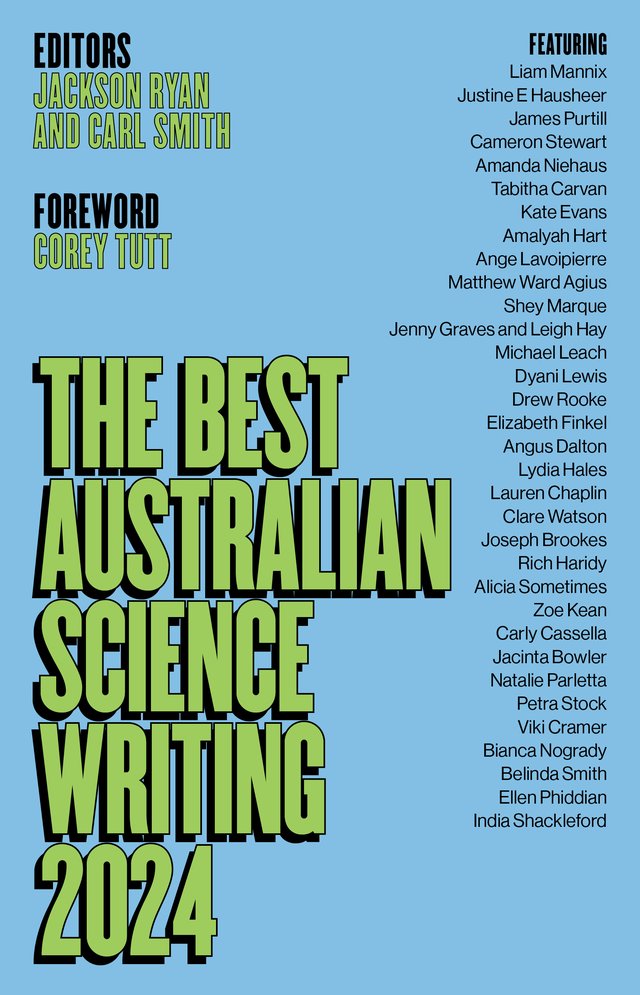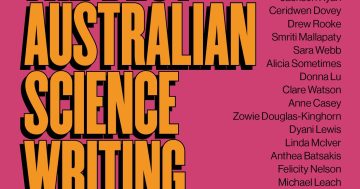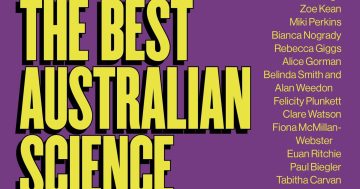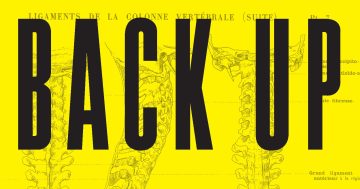
The best science writing doesn’t just answer questions, it cracks them open. It dissects, probes and solves their mysteries. The Best Australian Science Writing 2024 takes you on a journey of wonderful discoveries. Photo: Supplied.
Award-winning science journalists Carl Smith and Jackson Ryan begin by saying they are “humbled” after reading the submissions included in The Best Australian Science Writing 2024 compilation.
In the introduction, they describe the honour they feel to “read the work of our country’s best science writers and it’s remarkable to imagine that contained within these pages – which we view as our community’s series of stone tablets, arranged neatly for you – is just a single year’s worth of storytelling”.
The best science writing grabs us and pulls us deep into the story. It informs. Educates. It connects and deepens the human experience – and like all great stories throughout human history, it also surprises.
The collection doesn’t just answer questions, it cracks them open. It dissects them, probes and solves their mysteries. It’s a journey of discovery. Science is a deeply human endeavour and the stories we tell about it can be powerful, life-changing forces for good.
At times they can also be worrying glimpses of what might lie ahead. They can show us the climate models that are predicting our future, how emojis might empower a new generation of Kaytetye language speakers, as well as how scientists create your favourite chip flavour.
This much-loved anthology – now in its 14th year – selects the most riveting, entertaining, poignant and fascinating science stories from Australian writers, poets and scientists.
As well, the foreword, written by DeadlyScience founder Corey Tutt, brings to our attention the contribution to STEM, (science, technology, engineering and maths) by the first Australians. He discusses the sophisticated understandings they had relating to their environment, astronomy, land management and more. That these people are not acknowledged, and their perspectives not widely known, should be addressed.
It’s a miscellany covering an extraordinary year filled with major moments in science. It is a readily accessible path for people, as the writers present their topic with clarity and readability. The range of topics is incredibly wide and covers issues such as the long tail of COVID, and the changing aspects of science itself.
Ryan and Smith note that science writing is becoming a much more difficult proposition for many as publications close and falling rates force writers out of work. This mirrors a decline in media jobs more generally, “but losing science writers and journalists is a particularly cruel blow – one that can affect the public’s trust in science and make it harder to access crucial information to live a healthy, happy, safe life”.
“They pull us out of ourselves; we land in sully-formed worlds we could not previously imagine,” the authors say. “We are explorers, expeditioners, tourists and voyagers, all.”
Even as the threat of AI looms over the entire industry, this assortment of stories offers a captivating and recurrent, though pleasant, reminder that the most compelling tales are transportive.
The topics deal with issues such as needing depth and breadth in post-mortem examinations, how solar races have sustained Silicon Valley in unexpected ways, AI and drugs. Food chemists are also mentioned as the tastes of simple things such as chips take on new flavours.
Some stories start with a bang, others are slow burns, but the deep and rich tradition of storytelling feels fresh and fragile. Narratives shine because they fill a page in new and exciting ways. Many of the finest tales also remind us of those we share the planet with, and some celebrate the hero’s journey.
“Many of the classiest non-fiction stories put the writer in the frame. We celebrate well-told and reported stories of deep emotion, resilience and triumph. Some stories are a mirror that ask us to reflect on what we see in our lives and societies. Then, of course, there are many stories that bristle with moments of delight and entertainment, personality and flair.”
Starting in an exciting way is Liam Mannix’s descent into the Victorian forest or Bianca Nogrady’s piece, setting the tone with ”A good espresso coffee is sexy as hell’’ and then settling, warmly, in your chest as it drinks in the science of coffee. There’s urgency in Justine Hausheer’s sprint through the dark sands of the Solomon Islands at night, searching for endangered leatherback turtles to tag.
Cameron Stewart’s outstanding feature Heroes of Zero shows us how Michelle Haber and the Children’s Cancer Institute are slowly winning the fight against childhood cancer. Angus Dalton’s rollicking mystery adds another notch to the tally of Australian scientists beating ulcers.
Be enlightened with some current thinking through this scientific discourse!
The Best Australian Science Writing 2024, Edited by Jackson Ryan and Carl Smith, foreword by Corey Tutt, NewSouth Books, $32.99





